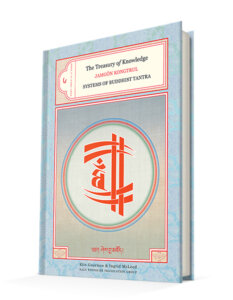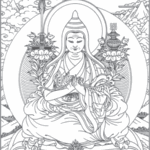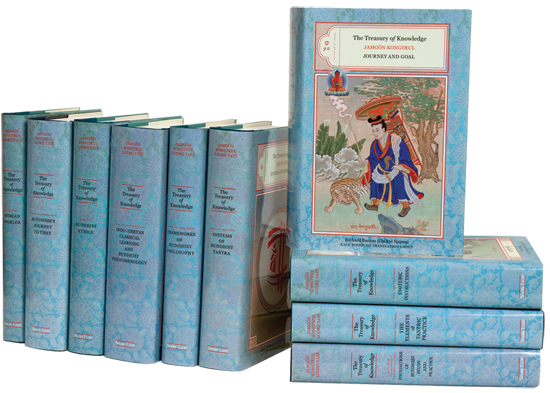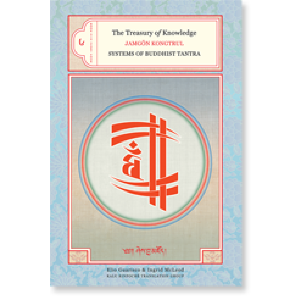 The following excerpts are taken from the introduction by Elio Guarisco to The Treasury of Knowledge, Book 6: Systems of Buddhist Tantra, by Jamgön Kongtrul Lodrö Tayé, translated by Ingrid Loken McLeod and Elio Guarisco
The following excerpts are taken from the introduction by Elio Guarisco to The Treasury of Knowledge, Book 6: Systems of Buddhist Tantra, by Jamgön Kongtrul Lodrö Tayé, translated by Ingrid Loken McLeod and Elio Guarisco
The Meaning of Tantra
To those who would embark on a quest for awakening, the Tibetan traditions of Buddhism offer three markedly different and seemingly incompatible sequences of practices: the individual way (hinayana); the universal way (mahayana); and the tantric way or secret mantra way (mantrayana).
While finding its foundation in the idealism (vijnanavada) and centrism (madhyamika) trends of thought, the tantric way undoubtedly sprang from the irresistible drive to know the nature of experience directly, unmediated by cognitive interpretation or emotional confusion. Consequently, it relies on an awareness that is an expression of the inner clarity present in our very being and not on knowledge derived from rational, philosophical, or conceptual processes.
Tantra consists of a skillful blending of three different types of practice: power methods, energy transformation methods, and intrinsic awareness methods. These methods came from a variety of sources and gradually formed into identifiable esoteric transmissions. Some practices were designed to break down social and cultural conditioning and others were developed to utilize basic energies in the body (including sexual energy) to enhance practice.
Etymologically, the word tantra is derived from the term for woof or weft, the thread that runs continuously through the fabric in traditional weaving methods. In Tibetan, the word means “continuum.” Both these meanings refer to the fundamental tantric perspective that the awareness that is the essence of being is always present, because it is not a thing, is not created, destroyed or subject to variation.
Although the terms tantra and mantra are often used interchangeably, they do have distinct meanings. Mantra denotes the pristine awareness of reality, the essence of which is emptiness and bliss, while tantra refers to the systems of implementation of such awareness for the sake of performing rituals and specific activities. The term mantra also serves as an abbreviation for “secret mantra” (guhyamantra), where mantra signifies “that which protects the mind” from dissipation due to ordinary perceptions and attachment to them. Mantras are commonly understood as incantations comprising series of syllables or words to be recited or visualized. Although this meaning may well have been the origin of the expression “secret mantra,” this represents only one of its minor aspects. Even the lower tantras, which stress the need for ritual activity, clearly state that, as means to gain realization, mantra recitation is secondary to formless contemplation. Mantra is called “secret” not to suggest the secretiveness of cults but because the path of mantra must be practiced in secret in order to be successful and withheld from unfit receptacles who could misuse it.
The term tantra is also used to refer to the essential meaning of mantra, as well as the entirety of the way of secret mantra. The first distinction to be made with respect to tantra is between tantra as the meaning, or content itself, and tantra as words or scriptures, the means for its transmission. The Continuation of the Guhyasamaja provides an encapsulation of tantra in terms of the meaning and its different aspects:
Tantra denotes continuousness.
It is composed of three aspects:
Ground, nature, and inalienableness.
When distinguished in this way,
The nature aspect is the cause;
The ground aspect refers to the method;
And inalienableness, the result.
These three contain tantra’s meaning.
Tantra as continuousness, or continuum (rgyud), refers to the uninterrupted presence of the original nature, or state of being, of each individual. In Buddhist scriptures, this original nature is principally referred to as “mind” (sems), as in “ever-perfect mind” (kun tu bzang po’i sems) or “mind nature” (sems nyid). In this context, “mind” does not mean object-bound experience but instead the ever-perfect and intrinsic awareness that has no beginning or end. Since it is free from the dichotomy of knower and known, this mind is no different from the reality it perceives. Reality is a “continuum” in the sense that its nature does not change into something else and cannot be fragmented into parts. Regardless of the degree of evolution or debasement of an individual, that reality or everperfect mind remains unaltered as the very essence or nucleus of one’s being. From the state of an ordinary individual, the beginning, so to speak, up to the end of awakening, such reality is unceasingly present. Hence, there is no ultimate distinction between an ordinary being and an awakened one.
Tantra, or continuum, although not subject to modification or partition, may be considered from the perspectives of non-recognition (conditioned existence), semi-recognition (the path), and total recognition (awakening) of original being. Based on these three phases, tantra is set forth in terms of its three aspects: actuality, process, and result.
Continuum as actuality (rang bzhin), though deemed causal (rgyu), does not mean the presence of the original state of being as a mere potential to be actualized in the future. Actuality points to the full presence of original being, even when it is not recognized. Lack of recognition is like a veil or cloud of unawareness which, however thick, does not pollute the very nature of one’s original state. As explained by the Third Karmapa Rangjung Dorjé, actuality means “an awakened being attended by stains.” Although accompanied by impurity, the being remains the same, just as a gold statue wrapped in rags is still a gold statue. “Causal” indicates that it is the fundamental element which when recognized is reaffirmed in its nature of enlightenment.
Actuality is not defined as an absolute and static emptiness. Its power of manifestation or “radiance” (mdangs), owing to unawareness of its nature and to emotional patterns related to unawareness, becomes the basis for the particular appearances or visions that seem to bind one. When the veils of unawareness and emotional patterns lessen to some extent, there arise pure visions and contemplative experiences reflecting the essential purity of the actuality. When unawareness and emotional patterns are fully recognized as the mere play of the manifesting power of reality, the entire breadth of the potential of one’s being unfolds.
Continuum as process, or method (thabs), refers to all of the various means by which one may recognize one’s original nature or being. These means are not restricted to those found in Buddhist traditions. In the highest forms of tantra, continuum as a process is primarily represented in the phase of generation (bskyed rim, utpatti krama) and phase of completion (rdzogs rim, nispanna krama) and their ancillary aspects. This process, in being the cooperative condition for coming to know one’s original state of being, is likened to manure spread over a field in order to nurture the growth of seeds. However, unlike the example, the very essence of the process does not involve external intervention but is simply original being recognizing itself. This process in tantra reflects, and is the exercise of, freedom and awakening, not in the sense of a goal attained but as a way of existing that manifests directly in every situation of life. The continuum aspect of the method or process exists in the relationship between the process and the original state of being, in the interdependent connections between the various aspects of the process, in the uninterrupted lineage of transmission of esoteric instructions, and in the contemplations and ensuing experiences.
In the ultimate sense, the actuality continuum, or causal continuum, does not denote a cause or seed that produces an effect since it already represents the fullest result. The process continuum does not refer to an outer agent but instead to an unfolding of what is already present. Likewise, the continuum as result, that of “inalienableness” (mi ’phrogs pa), does not mean the result of a pursuit or the attainment of a goal but the primordial condition itself. It is inalienable in that it has always been the authentic mode of being, never alienated by the split that occurs when one’s true nature is not recognized. It remains unmodified by the duality of conditioned existence and perfect peace, even when one is immersed in the seemingly real troubles of life.
The reality represented by tantra is known as the “authentic condition” (gnas lugs), which comprises that of both the inner and the outer, one’s mind and body and the totality of one’s world. However, this authentic condition primarily refers to the luminous clarity (’od gsal) of one’s mind, or pristine awareness, which all of the various tantric systems seek to manifest by way of their different methods.
The Doctrinal Basis of Tantra
The tantric systems incorporate all aspects of the Buddhist teachings, which, over the course of time, have served as their doctrinal bases. In particular, one central theory, which underlies every Buddhist approach, seems to be reflected in all the essential principles constituting the views and practices of tantra: that there exists an “element” (khams, dhatu) that enables an ordinary person to become a sublime being. That element is not the illusory and unreal self, the existence of which is negated on all levels of Buddhist philosophy. How then is it posited? The idea of such an “element” can be found in the more ancient form of Buddhism. In that context, as expressed by the analysts (vaibhasikas), and reflecting the character of a personal pursuit of liberation, it is known as “exalted affinity” (’phags pa’i rigs, arya gotra). It is defined as detachment from conditioned existence and worldly possessions and characterized as a state of contentment and having few desires.
From this basic formulation, the theory regarding this element has undergone a process of modification and refinement. For example, in the traditionalist (sautrantika) view, which represents a slightly more sophisticated philosophical trend than that of the analysts, the element is understood as not simply detachment but as a “seed,” an aspect of the mind capable of growing into supreme wisdom.
Around the time of the Third Buddhist Council, which took place two hundred and thirty-six years after the demise of the Buddha, the majority of the monastic community was turning attention to the needs and interests of the laity and trying to increase the chances for ordinary people to enter the path to freedom. This movement was accompanied by doctrinal transformations as a result of which the arhat or “saint” as the model for followers lost its preeminence. A new model emerged, that of the bodhisattva, who is willing to mingle with ordinary beings while working for their welfare and who, at the end of his or her spiritual career, achieves the goal of full awakening. Since the path of the bodhisattva leads the practitioner to the state of a buddha, or a “transcendent one” (tathagata), the element capable of turning into that state came to be known in the universal way tradition as the “essence of the transcendent ones” (tathagatagarbha) or “essence of enlightenment,” also referred to simply as buddha nature.
The two main philosophical trends within the universal way, that of the experientialists (yogacara) and that of the centrists (madhyamika), view such an element in ways that accord with their own basic tenets. The former asserts the element to be a potential present in the continuum of mind since time without beginning, capable of developing into the entire range of qualities of an awakened being. The latter asserts that it is the very nature of the mind (and of all phenomena) at the stage when mind is still attended by the stains of emotional patterns and limitations with regard to knowledge.
However defined, the essence of enlightenment corresponds to what in tantra is called “actuality” or the “causal continuum” (rgyu’i rgyud, hetu tantra), the original ground of being to be recognized as enlightenment itself. Thus, when we consider the above three aspects of tantra, it becomes apparent that tantra is based primarily on the theory of the essence of enlightenment or tathagatagarbha. Although ancient practices of pre-Buddhist origin were absorbed into the Buddhist tantric systems, it is this theory of Buddhist origin—the essence of enlightenment—that may be said to be the fundamental basis, or core teaching, from which tantra developed.



